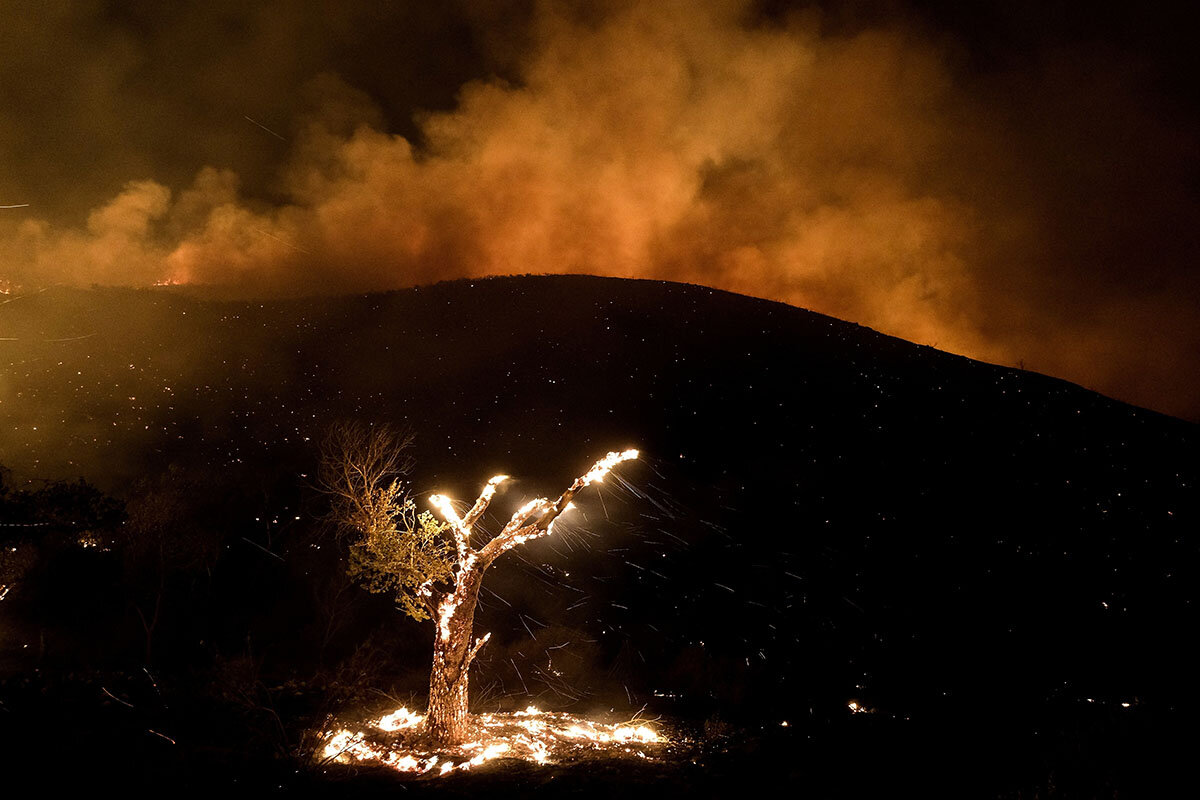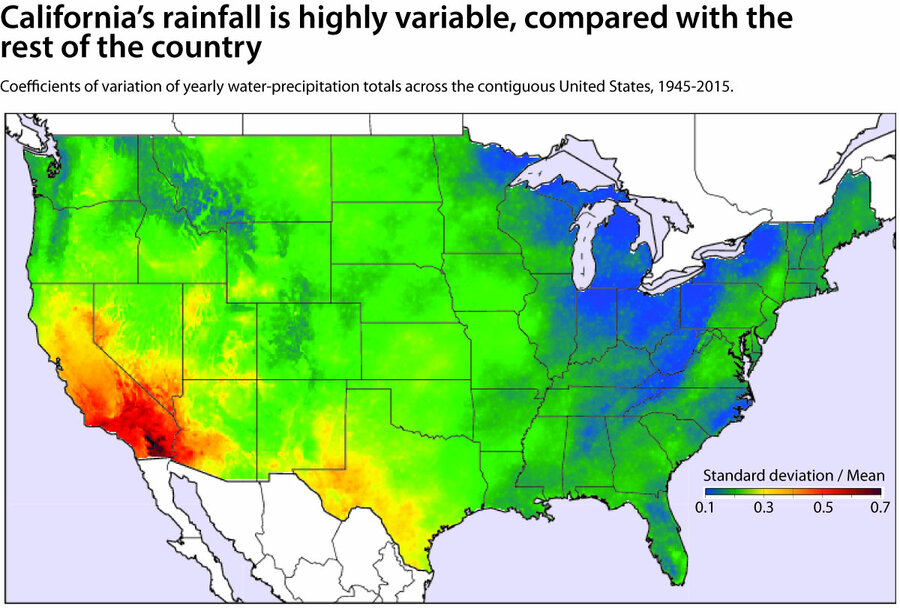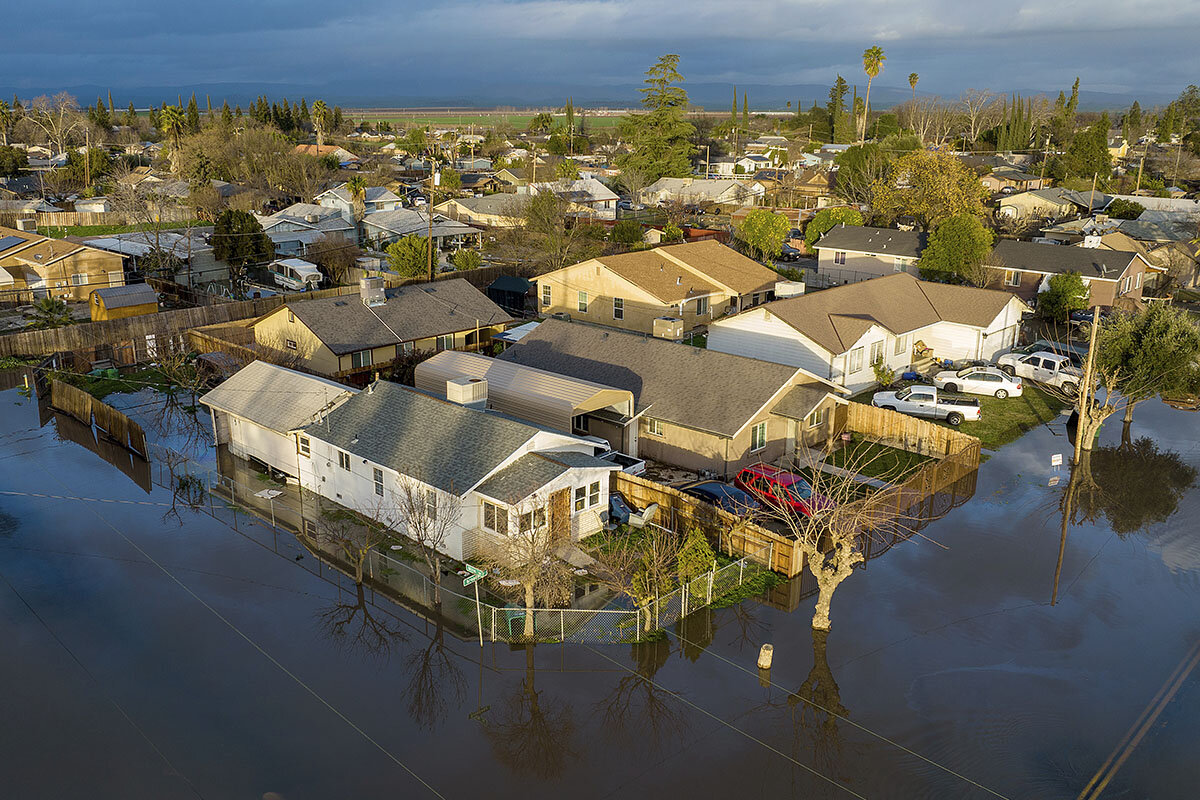‘Weather whiplash’ as Californians manage back-to-back extremes
Loading...
| Pasadena, Calif.
As Wallace Stegner, “the dean of Western writers,” once observed, California is like the rest of America, only more so. It’s a reference to the state’s character, but it could just as easily apply to its weather.
Extreme wildfires. Prolonged drought. And now, massive rain and flooding. In a surprise pummeling, along with the new year has come an unusually large number of powerful, back-to-back atmospheric rivers: narrow bands through the atmosphere that carry water vapor. They have flowed the length of the state – and blown destruction eastward across the United States. In the Golden State, they’re dumping rainfall that’s 400% to 600% above average in some places, forcing mass evacuations, closing highways, shutting down power, and killing 19 people.
“California is a land of extremes,” says Julie Kalansky, deputy director of the Center for Western Weather and Water Extremes at Scripps Institution of Oceanography. It stands out for having the greatest annual variation between wet and dry years in the continental U.S. Drought sets up conditions for intense wildfire, which sets up conditions for dangerous mudslides and flooding when heavy rain falls. Such cascading events make more extreme weather events possible, she says.
Why We Wrote This
California’s recent floods come atop other extreme events including fire and drought. Officials and residents are grappling with the wild swings in weather – and some adaptations may be helping.
And yet, California is “very forward-thinking” as it transitions to greater preparedness for extreme weather and climate change, observes Dr. Kalansky. That’s no easy task considering the variety of weather challenges, the size and geographic variation of the state, and its 40 million residents – the largest state population in the country. “They have to plan for all these different extremes,” she says. “But it is very complex to be able to do that all at the same time.”
Emergency prep: “record investments”
Brian Ferguson, deputy director of crisis communication at the California Office of Emergency Services, says the state has made “record investments’’ in emergency management over the past four years, with more planes, helicopters, and firetrucks than at any point in California’s history. The effort includes more first responders, law enforcement, and technology, too, he says. “We’re better prepared for these disasters because of that.”
Some of the investments do double duty. New planes with infrared capability to detect wildfires and their spread are also being used to fly over this year’s floods and identify the most dangerous areas.
The damage estimate from this season’s atmospheric rivers runs into the billions – a level that now could be typical alongside other disaster costs for the state, says Paul Ullrich, professor of regional and global climate modeling at the University of California, Davis. “We’ve been seeing ... billion-dollar disasters every year that have major socioeconomic repercussions associated with them, and we’re seeing no slowing down of the kinds of extreme weather events that we’re experiencing here.”
But preparedness efforts have made a difference, Professor Ullrich adds. Major floods have occurred throughout California history, he explains. Climate change has exacerbated them “a little bit,” but “overall, California is just inherently an extreme place.” Because of its history with floods, “we know what to do to some degree.”
“I know many places are still flooded. Nonetheless, I think that the damages are much less than they would have been maybe even 15, 20 years ago because of efforts put into building levees and water-management infrastructure that can deal with this level of rainfall.” He points specifically to reservoir management that, in conjunction with weather forecasting, controls reservoir levels when there’s major rain like this.
Long-term challenges
On the other hand, the state’s drought preparedness “is a major problem,” he says, primarily because of its economic reliance on agriculture, which accounts for 80% of water use. While the rainfall is helping with the drought in the short term by replenishing depleted reservoirs and adding significantly to the snowpack, it won’t do much for the long term, Professor Ullrich and others say, because of continued aridification of the West.
Mounting weather challenges put pressure on the state and individuals to better prepare, says Mr. Ferguson of the state’s emergency management office. Californians are well attuned after successive intense wildfire seasons to the dangers of fire, but they need to recover their muscle memory when it comes to excessive rain and flooding. After three years of drought, it’s “weather whiplash” to encounter this ongoing series of storms.
People underestimate the dangers posed by water, according to Mr. Ferguson, although the state’s deadliest disasters come from flooding. Many of the fatalities from these storms were preventable, he says, either by people evacuating or not driving through flooded areas. Just 12 inches of water can cause a driver to lose control of a vehicle.
Despite the state’s investment in emergency management, “there’s no amount of money that can keep up with the pace that our world is changing around us,” says Mr. Ferguson. That’s why local communities and neighbor-to-neighbor help are so important during dangerous events, he emphasizes.
Surviving fire, mudslide, and flood
Last Sunday night, as rain was pouring down and the worst of the storms was developing, two sheriff’s deputies came to the door of Dana and Corby Fisher in coastal Montecito, telling them of an evacuation order. It applied to the entire town of more than 8,000 people.
The Fishers live 100 yards from where, five years ago, the state’s deadliest mudslide killed 23 people and destroyed more than 100 homes. It followed on the heels of the massive Thomas Fire, which stripped the mountains above Montecito of their vegetation, leaving soil vulnerable when heavy rains arrived. The Fishers had just completed a kitchen remodel at the time. Their demolition container simply disappeared from the street and their car ended up in a neighbor’s yard. It took them a year and a half to restore their property.
Mr. Fisher is “impressed” with the sheriffs who came to their door in torrential rain, walking in the same spot where people had been swept away in January 2018. “For them to have that dedication is amazing,” he says, explaining that it’s why his son became a firefighter.
But the Fishers decided to shelter in place. Since the Thomas mudslide, his house is now surrounded by three concrete walls – two built by neighbors and one formed by the Fishers’ concrete planters. To protect themselves, they fortified their property with sandbags – and with prayer. “What you have to use is your God and your common sense,” he says in a phone interview.
The community has also taken steps over the last five years, expanding catch basins and building an additional one, as well as putting up steel-ring nets in canyons. Mr. Fisher believes much effort and cost could be saved with regular, prescribed burns. In any case, this time, there was no river of water and no mud coming down his street. “The water stayed in the creek, so our neighborhood was fine.”









